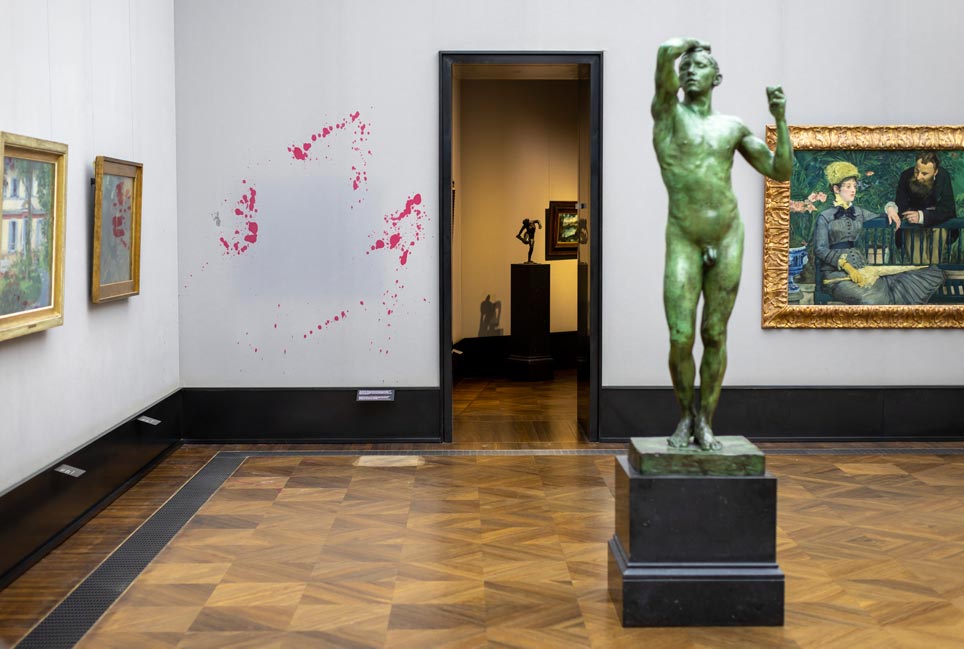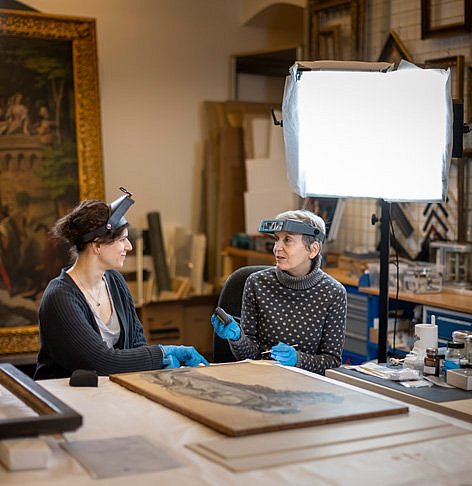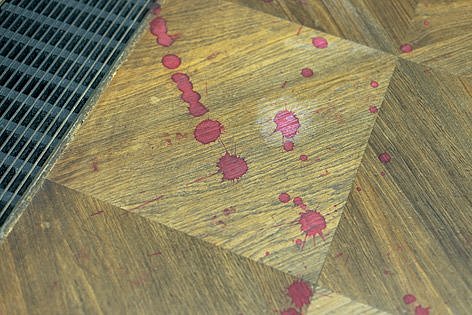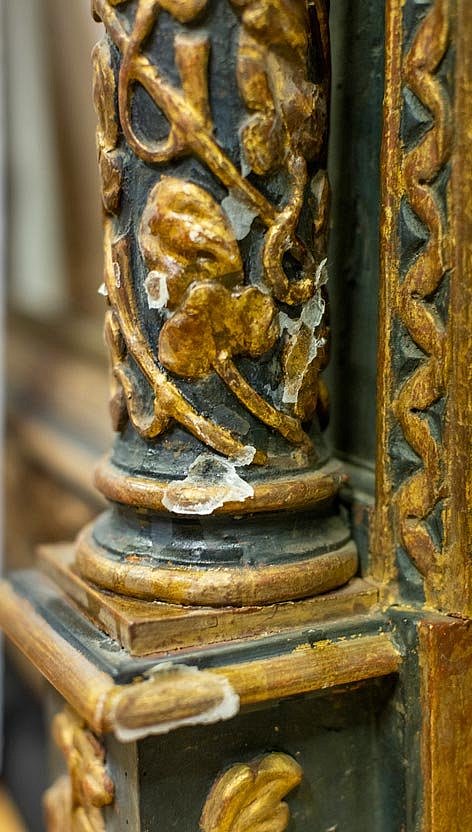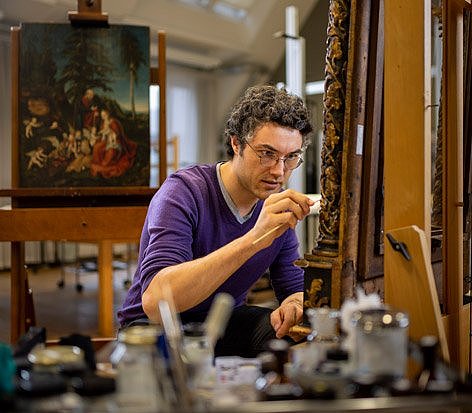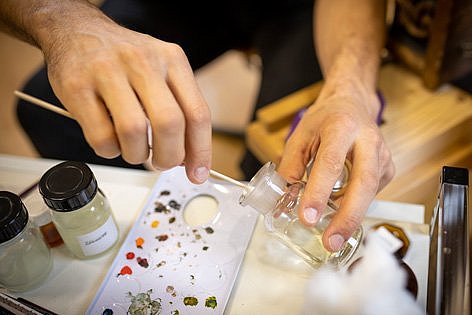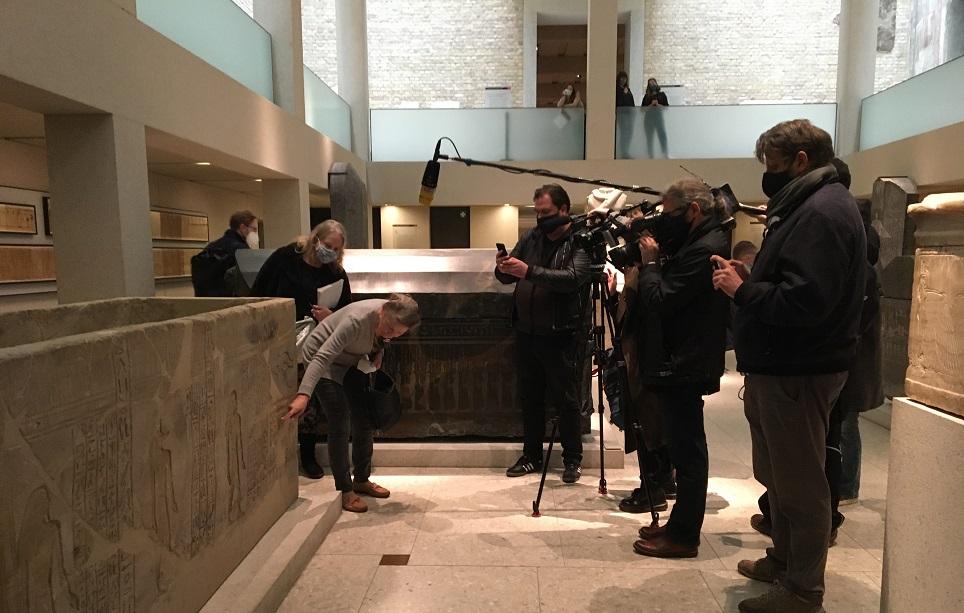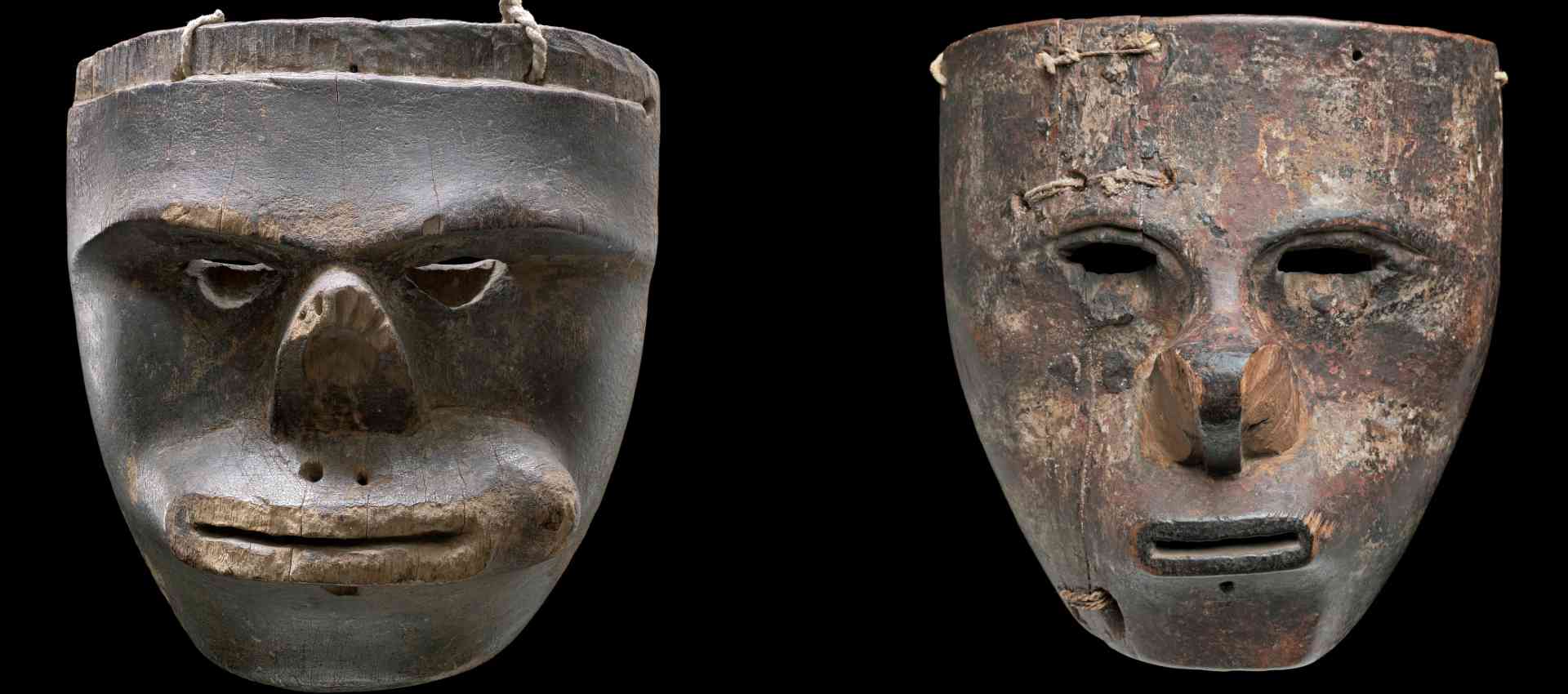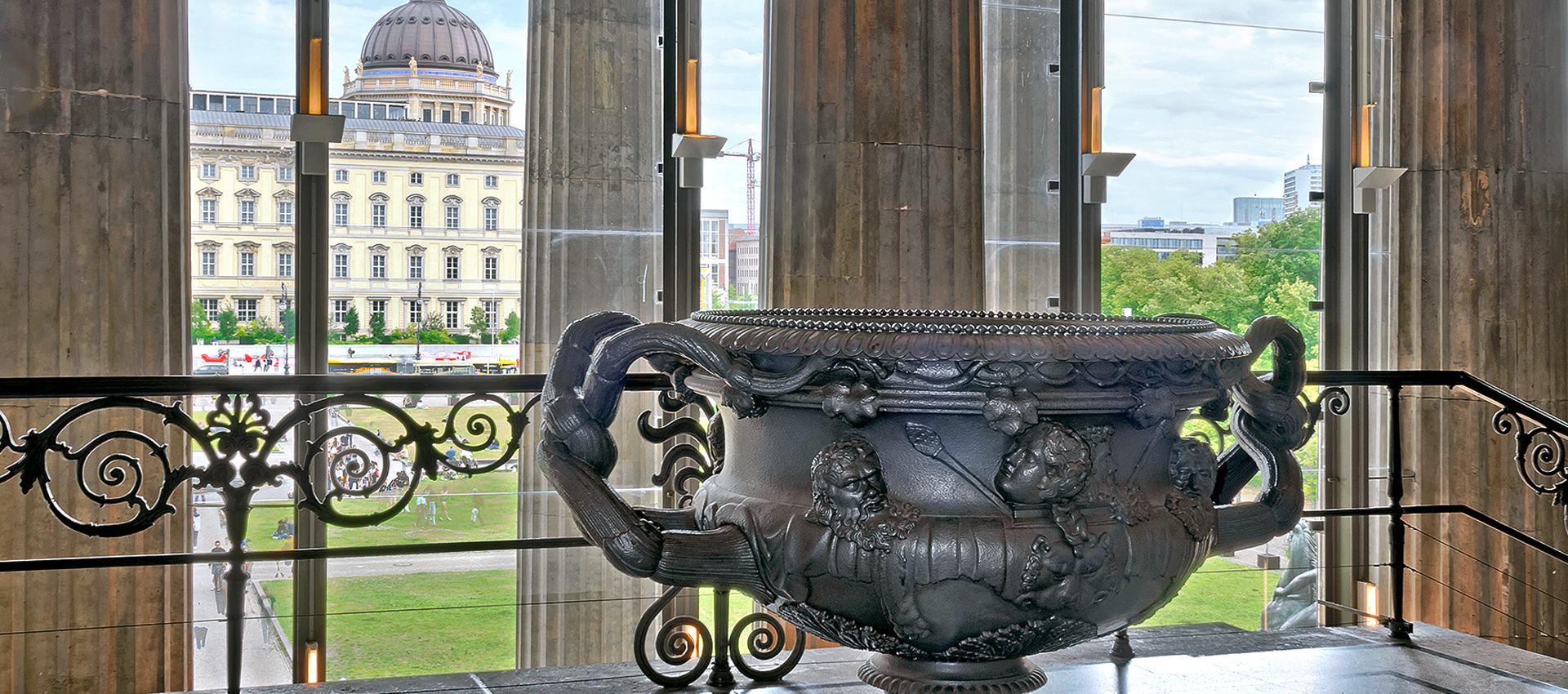Kristina Mösl and Bertram Lorenz deserve special recognition for their work in 2022. By applying their skills as restorers, they saved works of art that had been attacked in the Alte Nationalgalerie and the Gemäldegalerie.
There are dark red stains on the frame, at the bottom end of the canvas and on the frame spacers. A superficial glance might suggest that simply wiping away the red spots will make everything as good as new. But the dark red blemish is fake blood – a low-viscosity, intensely colored fluid that has penetrated deep into the wood.
The painting Clown (1887) by French artist Henri de Toulouse-Lautrec was hanging in the Impressionist room at the Alte Nationalgalerie when it was sprayed with fake blood by an attacker. The liquid stained not just the frame and picture itself, but also the wall covering and the only partially sealed wood of the parquet floor in the exhibition room. The stains are still visible many weeks after the attack. It was October 30 when the frame and the painting sustained “irreversible damage,” leading to an enormous depreciation of the picture as well as significant non-material losses, says Kristina Mösl. The picture and frame are both damaged to different degrees – a clear indication that the climate activists and their copycats who have kept the international museum world on tenterhooks this year have wantonly condoned a degree of collateral damage in the course of their protest activities.
Kristina Mösl, head of conservation and restoration at the Alte Nationalgalerie, is now working with her team to salvage whatever can be salvaged. “It’s a challenging task. The damage is massive,” she says. With her magnification glasses and an ultraviolet lamp, she inspects the black frame, which is now positioned on a large table at the improvised workspace in the museum’s storage rooms. Lying nearby are pipettes and cotton swabs along with bottles containing pigments, various chemicals and water.
First of all, the damaged parts of the picture and frame on both the front and back are photographed and documented. She expects that the restoration work on the frame will take two more weeks of work and that the picture won’t be ready to show the public again before the new year.
There is a stain at the bottom of the picture which is especially problematic. “The liquid has found its way past the glass and the frame spacers and got into the frame rabbet, so it has damaged the canvas, too.” Fortunately, she says, that part of the picture will not be visible when the painting is framed again. “But it’s not true that glazing completely and hermetically protects a picture,” she adds. That is only the case when fully glazed, climate-controlled frames are used, and that is mostly only when the pictures are shipped. “Those frames create an almost air-tight seal and have their own micro-climate inside the glass.”
The frame is not of the same vintage as the picture itself but was instead purchased by the museum later on – “but the frame and the painting nevertheless form an inseparable whole,” says Mösl. For decades, the Lautrec has been shown with the current frame.
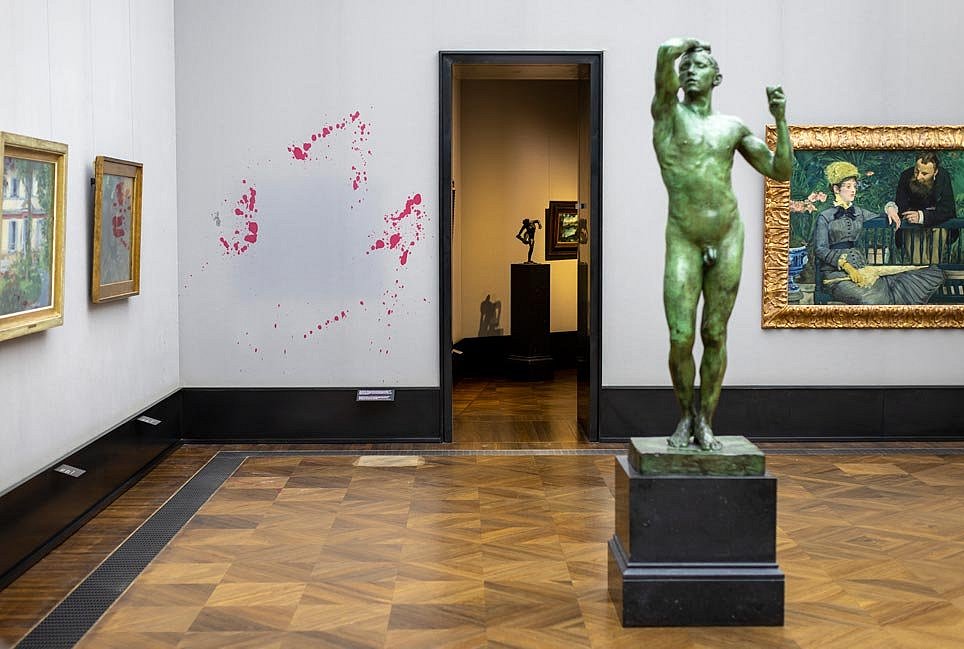
The painting "Clown", by the French artist Henri de Toulouse-Lautrec from 1887, which is exhibited in the Impressionist Hall of the Alte Nationalgalerie, was splashed with the art blood by a woman.
© SPK/photothek.net/Thomas Imo
It will not be possible to fully remove the traces of discoloration on the inner parts of the frame. “But in the end, when the picture and frame are put together again, they won’t be visible,” Mösl explains. At the moment, she and her colleague are experimenting with various materials to put some distance between the painting and the damaged surfaces on the frame. “Otherwise the red color might stain the picture itself.” The protective glazing has already been cleaned, and the felt on the inside of the frame has been replaced. But there are problems with the surface of the frame, too.
Separating the fake blood from the black paint of the frame “layer by layer” is a complex restorational challenge, Mösl says, because the frame paint and coating are likewise water-soluble. So it will not be possible to remove the fake blood entirely and without a trace; it will only be possible to reduce the amount of it. She intends to apply an “aqueous cleaning method” to the picture, in which the fake blood stain will be dissolved using gels. In the process, the protective coating on the frame will be partially dissolved as well. To compensate for any resulting visual anomalies, an attempt will then be made to give these parts of the frame a more consistent, uniform luster across the affected surfaces.
In general, every restoration project follows a characteristic “triad” of steps. First, there is an analysis of the damage, in which the object and the materials are examined. Then, there is the diagnosis, a description of the scope of the damage as manifested visually. Finally, there is the treatment, in which selected conservation and restoration techniques are used to rememdy the damage.
The sixty-year-old Mösl knows what a frame can mean to a picture. “The frame reshapes the painting and gives it a setting; it is always a creative, artistic element as well,” she says. After an apprenticeship as a wood carver, she completed a three-year internship at the Office for the Protection of Historical Monuments in Kiel. Then, she studied restoration at the Technische Hochschule (University of Applied Sciences) in Cologne. Since 2003, she has been head of the Conservation Department at the Alte Nationalgalerie.
Her responsibilities extend far beyond repairing damage. Mösl and her department are in charge of researching, conserving, and restoring the art at the Alte Nationalgalerie; supporting international loans and special exhibitions at the gallery with restoration and conservation services; and now and then designing new ornamental frames. But her team is prepared for any further attacks that may be made on the works of art in the collection. “For example, we have an emergency kit that we can use to undo fast-acting adhesives immediately,” she explains. This can be helpful in cases like the attack on the Toulouse-Lautrec painting, where the mentally ill woman responsible for the damage also glued herself to the wall in imitation of the method used by the Last Generation activists.
It was the early afternoon of August 25 when two young climate activists glued themselves to the frame of the painting Rest of the Virgin During the Flight Into Egypt by Lucas Cranach the Elder. The team of restorers at the Gemäldegalerie (Old Master Paintings) was in the room immediately. Within a few minutes, the two women staging the protest were freed from the frame. “The emergency call reached us at 3:10 PM, and by 3:23 PM, it was all over,” says Bertram Lorenz, one of the restorers at the Gemäldegalerie in Berlin.
All that is visible to an external observer is the white residue of glue in the shape of fingerprints. But if you look more closely, you can also see thin, paint-like streaks that cross the surface of the frame like threads.
Lorenz explains that to free the fingertips of the protesters, the restorers used acetone, a solvent that will not severely damage skin or other materials. In the process, elements of the frame were irretrievably lost, including some of the paint, gold and the patination consisting of tinted varnish. Furthermore, the dissolved adhesive seeped through the wood and into the frame. This gives rise to stains that can only be removed with great difficulty “through saturation or the use of solvents.” When a work of art is harmed, the damage is first meticulously inspected. It is documented in both written form and with photographs before work gets under way on the object.
Lorenz, 40, has likewise been working in the field of restoration for many years. His father had his own workshop for making picture frames. Through his father, he came into contact with the trade at an early age. Initially, he received instruction in gilding and completed his training as a master gilder. Later, Lorenz studied restoration at the Hochschule für Bildende Künste (University of Fine Arts) in Dresden. He wrote his dissertation at the Gemäldegalerie and then worked for a long time as a freelancer. Among other institutions, he has worked for the Stiftung Preussische Schlösser und Gärten Berlin-Brandenburg (Prussian Palaces and Gardens Foundation Berlin-Brandenburg). A few years ago, he began working for the Gemäldegalerie again.
“We’re glad that the picture by Lucas Cranach the Elder had glass over it,” says Lorenz. Painted in 1504, Rest of the Virgin During the Flight Into Egypt is considered one of the artist’s most important works. During the Second World War, the painting was removed from storage without its original frame. The frame that had been used up until that point was lost in the process. After the war, the Gemäldegalerie in West Berlin looked for a historically appropriate substitute on the art market and acquired the elaborately carved frame that has now belonged to the painting for 70 years. “It’s not the original frame, but it’s a historical frame, and the damage to it means a drop in value.” For Lorenz, too, a frame is much more than a protective glass surrounded by a wooden casing. “Every frame expresses something and is always a statement about the picture, too,” he says.
One problem for the restoration is that the activists removed the labels on the bottles of fast-acting adhesive. This is a problem because the various types of glue require different solvents. “So we have to perform different tests until we get close to the right approach, while at the same doing everything possible not to harm the original material.”
For the restoration of the frame, the panel painting had to be separated from it. The individual parts are lying on a large white table in the workshop: protective glass, setting, shims, wood spacers and insertion strips. Next to them is the Cranach painting, fixed in a wooden mount. Lorenz wraps a small wooden rod with cotton wool and dips it in acetone. He uses an ultraviolet lamp to illuminate the areas that have glue on them. “Many adhesives are fluorescent,” he says. “So with UV light, it’s easier to see and work on the areas with glue.” In addition to acetone, there are other solvents on the small tray trolley on which Lorenz has positioned his tools: petroleum benzine, methoxy propanol and Shellsol®.
The work on this frame will likewise take a total of one to two weeks, he says. It is a complex undertaking in this case, too, because the workshop at the Gemäldegalerie has to manage not only the everyday restoration work, but is also responsible for building frames in the context of international loans. That makes up a large part of his work, Lorenz explains.
Like Mösl, Lorenz says that it would never be customary to hermetically seal a work of art with its historical frame. “The frame and the painting inside it always have to be thought of as a whole, even in the case of an attack like this.” If complete protection is wanted, each work of art and its frame would have to be put into a display case. “But that would take away from the vitality of the paintings.” A museum like that would be nothing more than a protective vault.” That is something to keep in mind amidst the whole debate surrounding the Last Generation, says Lorenz.
Lorenz and Mösl both hope that there will not be any more incidents of this kind at the Staatliche Museen zu Berlin (National Museums in Berlin). “It’s right to protest about climate policies, but there has to be a discussion of the methods,” Lorenz says. “Museums keep and protect the cultural heritage of the human race,” adds Mösl – a mission that climate-protection activists should actually see as aligned with their concerns.
